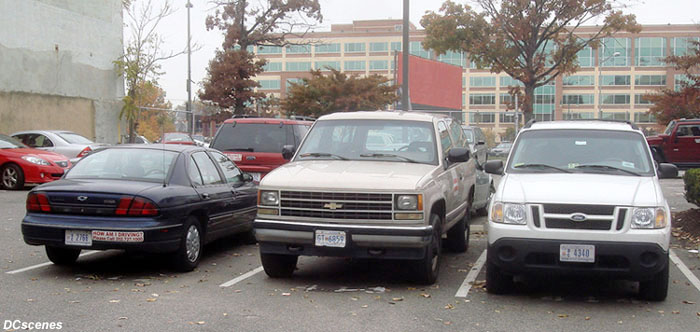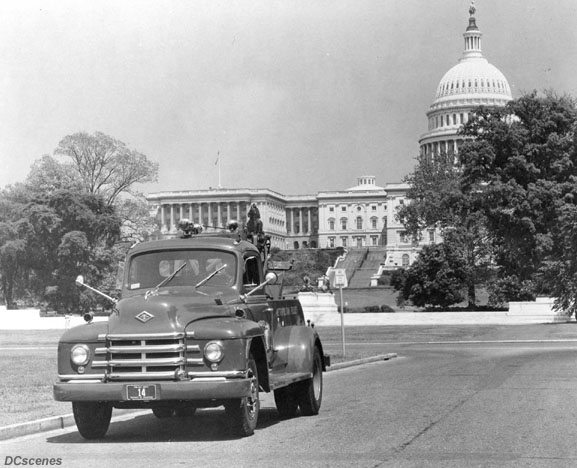Non-Passenger License Plates
Page IV: Government-Owned Types
| Police Dept. |
| D.C. Government | First Issued: 1927 |
|
 |
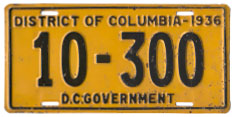 |
1933 |
1936 |
 |
 |
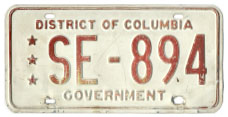 |
April 1952-March 1955 |
Beginning April 1955 |
c.late 1960s |
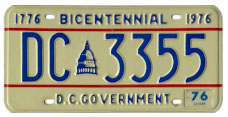 |
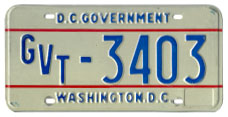 |
1974 baseplate |
1978 baseplate |
 |
 |
1984 baseplate |
1991 baseplate |
Taxation Without Representation Fleet Baseplates
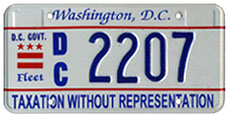 |
Embossed Style This is the first version of the D.C. Government fleet vehicle plate that includes Fleet and the Taxation Without Representation legend. It is thought to have been introduced simultaneously with or shortly after the design debuted in Nov. 2000, and the lowest and highest observed numbers are 0101 and 2406. |
|
Embossed/flat cutoff point documentation gap: 2407 to 2765 (359 numbers) |
||
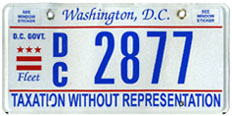 |
First Flat Style The lowest and highest observed numbers on the first style of flat fleet plate are 2766 and 6671. | |
Cutoff point documentation gap: 6672 to 6999 (328 numbers) |
||
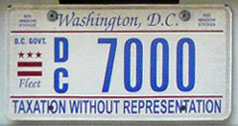 |
Second Flat Style The most noticeable characteristic on this variant of the flat fleet plate is the "g" in "Washington" that overlaps the red rule. The lowest and highest observed numbers are 7000 and 10443. It was probably in mid-2013 that numbers topped 9999 and were first issued in a five-digit format. The first sighting of a five-number plate reported to us occurred on August 24. |
|
Cutoff point documentation gap: 10444 to 10498 (55 numbers) |
||
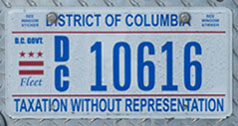 |
2014 Baseplate During the summer of 2014 D.C. Govt. plates began to be issued with DISTRICT OF COLUMBIA in place of WASHINGTON, D.C. The lowest observed example of this style is DC-10499. |
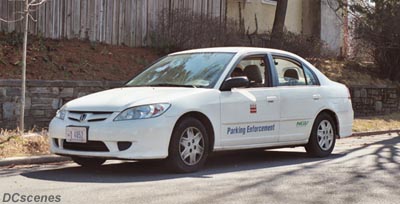 When letter prefixes began to be used on District of Columbia license plates in 1927 the letter A was reserved for plates operated by the District and federal governments. No evidence has been found to suggest that distinctively-marked plates were provided for government-owned vehicles prior to 1927. As shown with 1936 plate no. 10-300 above, by that year the types (D.C. and U.S. Government) had been separated, a change that probably occurred in 1935 when the system of using letter prefixes to differentiate types was discarded.
When letter prefixes began to be used on District of Columbia license plates in 1927 the letter A was reserved for plates operated by the District and federal governments. No evidence has been found to suggest that distinctively-marked plates were provided for government-owned vehicles prior to 1927. As shown with 1936 plate no. 10-300 above, by that year the types (D.C. and U.S. Government) had been separated, a change that probably occurred in 1935 when the system of using letter prefixes to differentiate types was discarded.
Beginning with the 1952 registration year, D.C. Government plates were changed from standard-looking plates with a G prefix to red-on-white plates with three stars, representing the city government's three commissioners, an example of which is no. 43 pictured above. Smaller plates, also red on white, were issued for government-owned motorcycles, although whether they include three stars is unknown. Plates of both sizes were considered permanent upon their introduction. “The numerals shall commence with 1 and continue in sequence to as high a number as is necessary,” according to a March 27, 1951, memo with which the new series was established. Plates of these two government types were not issued for use on police and fire department vehicles because separate types already existed for those agencies. In conjunction with this change, plates with a letter G prefix were released from restriction and issued to owners of privately-owned passenger vehicles.
The undated baseplate thought to have been introduced in the late 1960s, represented above by an image of plate no. SE-894, includes a two-letter prefix indicating the agency to which it was assigned. Identified prefixes and the corresponding departments are: BE, Board of Education; DC, Dept. of Corrections; FC, Federal City College; GF, (unknown agency); GS, General Services; HT, Highways and Traffic; PW, Public Welfare; and SE, Sanitary Engineering.
| D.C. Government Motorcycle | First Issued: unknown |
|

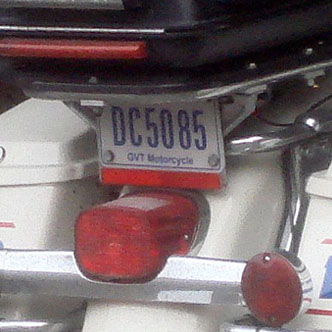
This rare type has been seen in use only on police motorcycles, but due to the plate not being marked Police it could be used on cycles operated by other city government departments, hence its present classification separate from Police Motorcycle. On both observed plate styles, with the registration number embossed (such as no. GM210 pictured, which was photographed in January 2007) and printed digitally (as with no. DC5085), the city name, Washington, D.C., is printed across the top in blue.
For how long plates of this type have been used is unknown. As of early 2008, and again in 2011, it was observed that most motorcycles operated by the Metropolitan Police were then registered with private motorcycle plates. What has caused a few to instead be identified with specially-numbered plates marked "GVT Motorcycle" is unknown.
As for earlier plates of this type, official documentation from late 1951 indicates that distinctive red-on-white plates were to have been introduced for use on D.C. Government-owned motorcycles in April 1952, but none have been observed.
| D.C. Water and Sewer Authority | First Issued: 2001 |
|
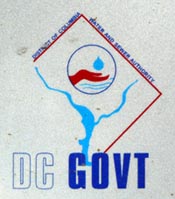 |
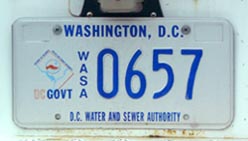 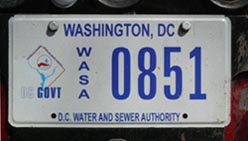 |
|
| This type is thought to have been introduced in 2001. Both versions (embossed and flat) of the first-issue base include an outline of the District with DISTRICT OF COLUMBIA and WATER AND SEWER AUTHORITY printed in small letters on the northwest and northeast boundary lines. DC GOVT is printed in larger letters below the logo, although the letters DC, printed in outline characters in red on plates with an embossed number and blue on flat plates, are barely legible. The lowest and highest numbers observed on plates with an embossed registration number are 0089 and 0658, and the lowest and highest numbers seen on flat plates are 0851 and 0957. |
| The D.C. Water and Sewer Authority, established in 1996, billed itself as DC WASA until it underwent a rebranding campaign announced on June 15, 2010. Since then known as DC Water, the change was incorporated in a variety of mediums, including new license plates for its vehicles. Exactly when the new plates were introduced is unknown, although it is thought to have been in late 2011, not long before number 183 was observed on October 7. | 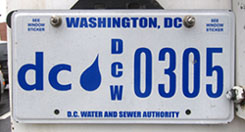 |
| Fire Department | Earliest Known: 1950s |
|
 Tracing the history of this type is difficult due to the small quantity of plates issued throughout the years and the lack of a year designation on them. Fire Dept. plates have always been white on red, issued in pairs, and included the FIRE DEPT. type designation. It has been assumed that these plates were introduced during the 1930s when Police Dept. plates are thought to have first been issued. Special Fire Dept. plates are known to have been in use by October 1951, for it was then that an earlier 1951 D.C. Board of Commissioners memo in which a provision for new, distinctive license plates for vehicles operated by the city government was “hereby amended by excluding the Police Department, D.C. and the Fire Department, D.C., both departments having special identification plates.”
Tracing the history of this type is difficult due to the small quantity of plates issued throughout the years and the lack of a year designation on them. Fire Dept. plates have always been white on red, issued in pairs, and included the FIRE DEPT. type designation. It has been assumed that these plates were introduced during the 1930s when Police Dept. plates are thought to have first been issued. Special Fire Dept. plates are known to have been in use by October 1951, for it was then that an earlier 1951 D.C. Board of Commissioners memo in which a provision for new, distinctive license plates for vehicles operated by the city government was “hereby amended by excluding the Police Department, D.C. and the Fire Department, D.C., both departments having special identification plates.”
In addition to regular serially-numbered plates, special plates with only letters are made for use by department officials. For example, FC is used by the chief, DFC by the deputy chief, etc. Plates used on ambulances operated by the department have an AMB prefix to the number.
| Police Dept. | Earliest Known: 1940s |
|

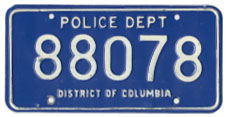
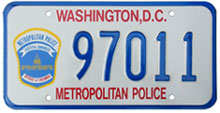
It's difficult to determine the age of most Washington, D.C. Police Dept. license plates simply because they have always been undated. The type is believed to have been issued at least as early as the mid-1930s based upon the existence of a sample from that era. However, the earliest identified used plate is from the 1940s. Plates of this type have always been issued singly and, until recently, were always painted white on blue.
The earliest D.C. police plates are numbered with up to four figures, and on some of them the first digits signify to which of the city's then 14 police precincts the vehicle was assigned. Plate no. 82 pictured, which is steel and appears to have not been used, is an example. On the back is a typed label, believed to have been added by a plate collector, indicating that it is of the type issued and used prior to 1972 and that the number indicates issuance in the 8th precinct (Georgetown) to scout (patrol car?) no. 2.
In 1973 the District's police precincts were redefined and renamed districts, and it was at this time that police registration numbers were reformatted to be comprised of five numbers, the first two of which indicate the model year of the registered vehicle. Numbers 88078 and 97011 are examples.
| Police Motorcycle | Earliest Known: 1950s |
|



Like Police Dept. plates issued for use on full-size vehicles, motorcycle plates of this type have always been issued singly, and until recently they were painted white on blue. On plates with a five-number format, such as nos. 73191 and 81492 pictured, the first two numbers are believed to indicate the vehicle model year. Note the different legends on these two examples. The MP-prefix plate is, based upon its dimensions and dies, believed to be from the 1960s or early 1970s. (See also the D.C. Government Motorcycle section above.)
| Metro Police | First Issued : unknown |
This may be a Maryland, not D.C., type. |

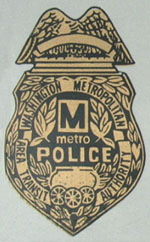 This type is issued exclusively to the Washington Area Metropolitan Transit Authority (the "Metro") for use on its vehicles used in law enforcement. Like similar authorities that exist in other parts of the Untied States, such as the Port Authority of New York and New Jersey, the Metro was created to design, construct, maintain, and manage the operation of a public transportation system comprised primarily of buses, trains, and subways that serve more than one registration-issuing jurisdiction. The Metro owns property in Maryland, Virginia, and Washington, D.C., hence the need for a quasi-public entity not under the control of any one state or the District of Columbia.
This type is issued exclusively to the Washington Area Metropolitan Transit Authority (the "Metro") for use on its vehicles used in law enforcement. Like similar authorities that exist in other parts of the Untied States, such as the Port Authority of New York and New Jersey, the Metro was created to design, construct, maintain, and manage the operation of a public transportation system comprised primarily of buses, trains, and subways that serve more than one registration-issuing jurisdiction. The Metro owns property in Maryland, Virginia, and Washington, D.C., hence the need for a quasi-public entity not under the control of any one state or the District of Columbia.
Metro police vehicles are used to patrol various properties under the Authority's control. Note that the plates are not marked with the name of any jurisdiction. In which of the three jurisdictions in which the Metro owns property Metro Police vehicles are actually registered is unknown, so it is entirely possible that this actually is not a Washington D.C. registration and plate type at all. In fact, the plate most closely resembles law enforcement-related types issued in Maryland, so this may be a Maryland, not D.C., registration type.
| U.S. Government | First Issued: 1927 |
|
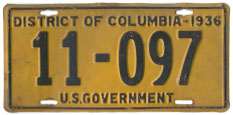
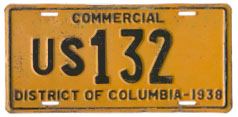
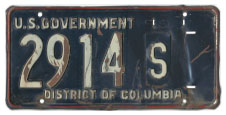
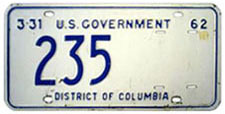

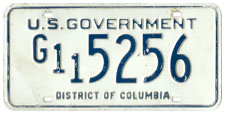
When letter prefixes began to be used on District of Columbia license plates in 1927 the letter A was reserved for plates operated by the District and federal governments. (An example is shown above.) No evidence has been found to suggest that distinctively-marked plates were provided for government-owned vehicles prior to 1927. The types (D.C. and U.S. Government) had been separated by 1936, with the type name clearly embossed, a change that probably occurred in 1935 when the system of using letter prefixes to differentiate types was discarded.
Except for the 1938 example, provision has been made on each plate shown for the identification of a particular federal government department. On the white-on-dark blue plate the small letter S suffix, displayed on a tab, indicates State Dept. use. Based upon the year tab slots to the right of U.S. GOVERNMENT, this plate, with an unusual embossed red border, is believed to date from the mid- to late 1950s.
Some plates included two-letter agency codes, hence the two tab slots on some of these plates. Based upon the spacing of plate number 9089 and the lack of agency tab slots, perhaps the agency was to have been indicated on a decal placed to the right of the number. The G of the prefix on plate no. 5256 indicates assignment by the General Services Administration to its Interagency Motor Pool System, and the 11 indicates use on an intermediate or subcompact passenger car.
Plates for U.S. Government vehicles that do not include DISTRICT OF COLUMBIA are addressed on a separate page.
|
This page last updated on December 31, 2017 |
 |
|
copyright 2006-2018 Eastern Seaboard Press Information and images on this Web site may not be copied or reproduced in any manner without consent of the owner. For information, send an e-mail to admin@DCplates.net |















